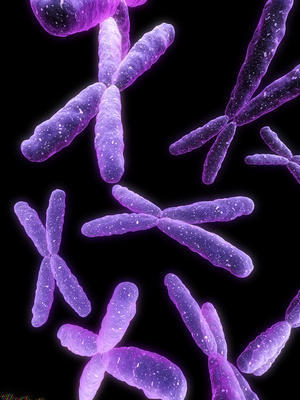
科学家第一次发现了消瘦的遗传学病因。该发现发表在8月30日的《Nature》杂志上。研究发现,某特定基因具有多余拷贝数的人群更易体形消瘦。每2000人中就有1个人的第16条染色体上有一部分出现复制,这使得具有这种情况的男人出现体重过轻的几率是普通人的23倍,女人为5倍。
一般地,每个人从父母双方分别得到1拷贝的染色体,因此我们对每个基因都有2个拷贝。但是,有的时候染色体上的一部分可能会被复制或缺失,导致出现不正常的基因“用量”。
在该研究中,伦敦帝国理工学院和洛桑大学的研究人员检测了超过95000人的DNA,鉴定发现,在第16号染色体上部分片段的复制与体重过轻(即体重指数低于18.5)有关。在该研究中,具有这种染色体复制现象的儿童中有一半被诊断为“生长障碍”,这意味着他们的体重增长速度明显低于普通小孩。四分之一的具有这种复制现象的人具有头小畸形,表现为头和大脑要比正常情况小,这与神经缺陷和寿命短有关。去年,这些研究人员就发现,在这些基因上有拷贝数缺失的人群出现病态肥胖的几率会提高43倍。
伦敦帝国理工学院公共健康学院的Philippe Froguel教授主导了这项研究,他说:“教条的说法是,我们的每个基都为双拷贝的,其实这不正确。基因组上充满了丢失基因的缺口,而在另外的地方又有多余基因拷贝数。很多情况下,丢失或复制没什么影响,但是偶尔会导致疾病。”
“目前为止,我们已经发现了大量导致肥胖的遗传学变化。看起来我们具有很多提高食欲的系统,因为进食对我们太重要了,你可以压制某个系统,但是无济于事。这是第一次鉴定出导致极端消瘦的遗传学病因。”
“这非常重要,一个原因就是这表明儿童的生长障碍可以通过遗传引起。小孩不吃饭,并不是父母的错。”
“这也是发现的第一例基因组缺失和复制表现出相反的影响。目前我们对这个区域的基因还不了解。如果我们能够弄清楚为什么这部分基因的复制会导致消瘦,那么就有可能产生新的针对肥胖和食欲类疾病的疗法。我们现在计划将这些基因进行测序然后找到他们的功能,从而我们可以知道哪一个是调节食欲的。”
该研究涉及的16号染色体包含28个基因。之前的研究发现在这一区域发生的复制与精神分裂有关,而缺失则与孤独症有关。
生物探索推荐阅读:
罕见基因变异可明显“塑身”
生物探索推荐论文摘要阅读:
Both obesity and being underweight have been associated with increased mortality. Underweight, defined as a body mass index (BMI) ≤ 18.5 kg per m2 in adults and ≤ −2 standard deviations from the mean in children, is the main sign of a series of heterogeneous clinical conditions including failure to thrive, feeding and eating disorder and/or anorexia nervosa. In contrast to obesity, few genetic variants underlying these clinical conditions have been reported. We previously showed that hemizygosity of a ∼600-kilobase (kb) region on the short arm of chromosome 16 causes a highly penetrant form of obesity that is often associated with hyperphagia and intellectual disabilities. Here we show that the corresponding reciprocal duplication is associated with being underweight. We identified 138 duplication carriers (including 132 novel cases and 108 unrelated carriers) from individuals clinically referred for developmental or intellectual disabilities (DD/ID) or psychiatric disorders, or recruited from population-based cohorts. These carriers show significantly reduced postnatal weight and BMI. Half of the boys younger than five years are underweight with a probable diagnosis of failure to thrive, whereas adult duplication carriers have an 8.3-fold increased risk of being clinically underweight. We observe a trend towards increased severity in males, as well as a depletion of male carriers among non-medically ascertained cases. These features are associated with an unusually high frequency of selective and restrictive eating behaviours and a significant reduction in head circumference. Each of the observed phenotypes is the converse of one reported in carriers of deletions at this locus. The phenotypes correlate with changes in transcript levels for genes mapping within the duplication but not in flanking regions. The reciprocal impact of these 16p11.2 copy-number variants indicates that severe obesity and being underweight could have mirror aetiologies, possibly through contrasting effects on energy balance.







